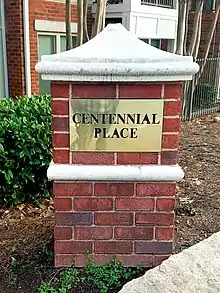Atlanta mixed-income communities
In 1996, The Atlanta Housing Authority (AHA) created the financial and legal model for mixed-income communities or MICs, that is, communities with both owners and renters of differing income levels, that include public-assisted housing as a component. This model is used by the U.S. Department of Housing and Urban Development's HOPE VI revitalization program. As of 2011, it has resulted in all housing projects having been demolished, with partial replacement by MICs.[1]
The first of these, Centennial Place, has been recognized by HUD and the Urban Land Institute. As of 2007, Centennial Place had a math, science and technology-focused elementary school, a YMCA, a branch bank, a child-care facility and retail shops. There were plans to include homeownership units.[2]
In 2011, the agency also tore down the Roosevelt House and Palmer House senior-citizen high-rises and relocated residents into other properties.[3] However, the John O. Chiles and Cosby Spear senior citizen high rises remained open.[2]
AHA took advantage of relaxed federal rules in effect through 2010 to raze all remaining communities. The agency offered residents who qualified a variety of relocation options and long-term assistance that included federal rent-assistance vouchers good anywhere in the country.[4] However, not all residents qualified for the vouchers.
List of mixed-income communities
Ashley Auburn Pointe
Site of former Grady Homes in the Sweet Auburn neighborhood. Includes the Veranda at Auburn Pointe complex.
Ashley College Town
Site of former Harris Homes,[5] built 1956
Ashley Courts at Cascade
Site of former Kimberly Courts, off-site for Techwood/Clark Howell
Ashley Terrace at West End
Formerly off-site for Techwood/Clark Howell
Capitol Gateway
Site of former Capitol Homes

Centennial Place
Site of former Techwood Homes and Clark Howell in the Centennial Hill district of Downtown Atlanta
Columbia at Mechanicsville Station
Replaced the 41 acres (17 ha) 293-unit[6] McDaniel-Glenn Homes in the northwest corner of Mechanicsville, torn down between February and May 2006.[7]
Columbia Commons
Formerly off-site for East Lake Meadows
Columbia Village
Formerly off-site for East Lake Meadows
Summerdale Commons
In NPU Z in southwest Atlanta. Recognized by the city as an official neighborhood of Atlanta.
The Villages at Carver
Site of former Carver Homes in southeast Atlanta, west of South Atlanta and east of Joyland and High Point. Recognized by the city as an official neighborhood of Atlanta.
The Villages of Castleberry Hill
Site of former John Hope Homes. Recognized by the city as an official neighborhood of Atlanta. Despite the name, this community is not in Castleberry Hill and lies south of that neighborhood.
The Villages of East Lake
Site of the former East Lake Meadows. The redevelopment was driven by developer and philanthropist Tom Cousins. Recognized by the city as an official neighborhood of Atlanta.
West Highlands
An official neighborhood of Atlanta. Site of former Perry Homes, which were demolished in 1999.[9] Includes
- Columbia Estates, 124 townhouses and garden-style apartments, for rent
- Columbia Heritage, a 132-unit mixed-income seniors housing development
- Columbia Park Citi, a 154-unit mixed-income garden-style apartment complex
- Columbia Crest, a 152-unit mixed-use project with 5,000 square feet (460 m2) of retail space; and
- Columbia Grove, a 138-unit multifamily project that will be the final phase[10]
Senior citizen highrises
While Palmer and Roosevelt were razed, these senior citizen highrises were renovated:
Cosby Spear
On North Avenue in the Old Fourth Ward
John O. Chiles
Located at 435 Joseph E. Lowery Blvd. Renovated 2008.
References
- "AHA Web site". October 7, 2003. Archived from the original on June 29, 2007. Retrieved July 5, 2007.
- "Atlanta Journal-Constitution". April 29, 2007. Archived from the original on September 27, 2007. Retrieved July 5, 2007.
- Ariel Hart, "Atlanta building -- and old public housing model -- demolished", 'Atlanta Journal-Constitution, February 27, 2011
- "Atlanta Journal-Constitution". February 14, 2007. Archived from the original on September 28, 2007. Retrieved July 5, 2007.
- "Atlanta NPU T site". Archived from the original on October 9, 2011. Retrieved April 11, 2011.
- "TSW and Associates | McDaniel Glenn Public Housing Development in Mechanicsville". Archived from the original on March 22, 2012. Retrieved February 28, 2013.
- "Hard Hat News". Archived from the original on March 22, 2012. Retrieved April 11, 2011.
- ""Magnolia Park", Atlanta Housing Authority". Archived from the original on October 8, 2011. Retrieved April 11, 2011.
- "Blighted housing project could become site of 462-acre community with golf course", Atlanta Journal-Constitution, 2000-04-01
- "eric Wong, "Saved by Hope VI",Affordable Housing Finance". Archived from the original on January 5, 2011. Retrieved April 11, 2011.